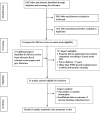Evidence-based approaches to childhood stunting in low and middle income countries: a systematic review
- PMID: 28468870
- PMCID: PMC5739821
- DOI: 10.1136/archdischild-2016-311050
Evidence-based approaches to childhood stunting in low and middle income countries: a systematic review
Abstract
Objective: We systematically evaluated health and nutrition programmes to identify context-specific interventional packages that might help to prioritise the implementation of programmes for reducing stunting in low and middle income countries (LMICs).
Methods: Electronic databases were used to systematically review the literature published between 1980 and 2015. Additional articles were identified from the reference lists and grey literature. Programmes were identified in which nutrition-specific and nutrition-sensitive interventions had been implemented for children under 5 years of age in LMICs. The primary outcome was a change in stunting prevalence, estimated as the average annual rate of reduction (AARR). A realist approach was applied to identify mechanisms underpinning programme success in particular contexts and settings.
Findings: Fourteen programmes, which demonstrated reductions in stunting, were identified from 19 LMICs. The AARR varied from 0.6 to 8.4. The interventions most commonly implemented were nutrition education and counselling, growth monitoring and promotion, immunisation, water, sanitation and hygiene, and social safety nets. A programme was considered to have effectively reduced stunting when AARR≥3%. Successful interventions were characterised by a combination of political commitment, multi-sectoral collaboration, community engagement, community-based service delivery platform, and wider programme coverage and compliance. Even for similar interventions the outcome could be compromised if the context differed.
Interpretation: For all settings, a combination of interventions was associated with success when they included health and nutrition outcomes and social safety nets. An effective programme for stunting reduction embraced country-level commitment together with community engagement and programme context, reflecting the complex nature of exposures of relevance.
Prospero registration number: CRD42016043772.
Keywords: Stunting; low and middle income countries; prevention strategies; programs; systematic review.
Published by the BMJ Publishing Group Limited. For permission to use (where not already granted under a licence) please go to http://www.bmj.com/company/products-services/rights-and-licensing/.
Conflict of interest statement
Competing interests: None declared.
Figures
References
-
- World Health Organization. WHO Child Growth Standards: Length/height-for-age, weight-for-age, weight-for-length, weight-for-height and body mass index-for-age: Methods and development. In: World Health Organization, ed. WHO Child Growth Standards. Geneva: World Health Organization, 2006.
-
- UNICEF. Improving child nutrition: the achievable imperative for global progress. New York, USA: United Nations Children's Fund, 2013.
-
- Resnick D, Babu SC, Haggblade S, et al. . Conceptualizing drivers of policy change in agriculture, nutrition, and food security: The kaleidoscope model. IFPRI Discussion Paper 1414 Washington DC: International Food Policy Research Institute (IFPRI), 2015.
Publication types
MeSH terms
LinkOut - more resources
Full Text Sources
Other Literature Sources
Medical



